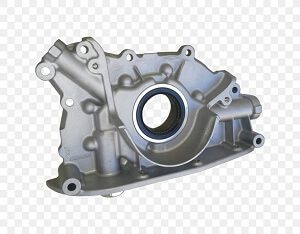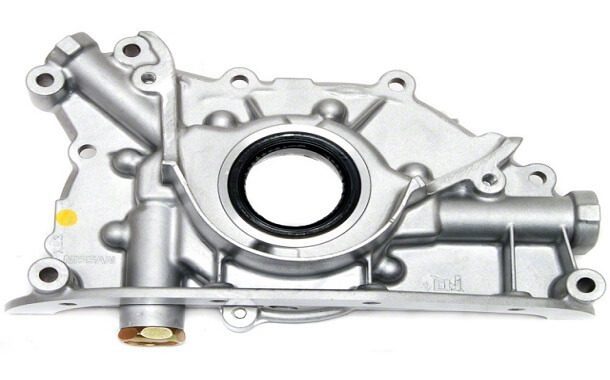Oil Pump Replacement Cost
Last Updated on December 27, 2023
Written by CPA Alec Pow | Content Reviewed by ![]() CFA Alexander Popinker
CFA Alexander Popinker
The oil pump is an essential element in the lubrication system of a car engine. Its main task is to create oil pressure in the lubrication system, making it possible to supply engine oil to the moving parts of the internal combustion engine.
Oil pump failures can significantly damage a car’s engine as this interferes with the normal flow of engine oil through the system. So, it is extremely important to replace it when it doesn’t work properly.
How much does it cost to replace your car’s oil pump?
The cost of an oil pump replacement will be influenced by some factors such as the make and model of your vehicle, the place where you are living, and the mechanic you choose. You should expect to pay anywhere between $310 and $1,100. Though, there are situations when you may have to pay as much as $1,400.
The price of the pump itself would be anywhere between $110 and $420, while the labor cost will make up for the rest of the entire bill.
You will most probably need a standard oil pump unless you have a racing or a high-performance engine. However, if you do have a high-performance engine, you will need a high-performance or high-volume oil pump.
The first thing you will need to know before purchasing a new oil pump is the type of pump. The way your engine is used will tell you what type of engine oil pump you will need.
You might also like our articles about the cost of an oil pan replacement, oil leak repair, or oil change.
Below you will find some features of standard, high-volume, and high-pressure oil pumps.
| Type of Pump | Characteristics |
| Standard Oil Pump |
|
| High-Pressure Oil Pump |
|
| High-Volume Oil Pump |
|
If you have a racing or a high-performance engine, you will need a high-volume or a high-pressure oil pump. However, most of the vehicles will need a standard oil pump.
Oil pump overview
The oil pump has the role of ensuring the oil flow at the required pressure in the oil circuit.
The oil pump creates a vacuum in the system by sucking the lubricant from the oil pan through the oil tank. In the process of moving along this line, the oil is filtered through a full flow sequential filter. The oil passed through the pump enters the main pipe, and from there it is distributed and supplied to consumers in accordance with their operating conditions. So the crankshaft and camshaft bearings receive oil at maximum pressure, the timing gears, the valve mechanism, and part of the cylinder mirror are spray lubricated and the oil flows to the rods, pushers, and cams by gravity.
The oil pump is driven by the crankshaft through a gear, or a belt drive can be used. In any case, the operation of the oil pump is synchronized with the engine speed. The only exception is that some powerful supercharged internal combustion engines may have an electric oil pump that supplies turbine oil even after the engine has stopped the cooling of the turbocharger.
Symptoms of a defective oil pump
There are several typical symptoms of a defective oil pump, such as:
Increased oil consumption: Occurs due to leakage of damaged seals or residues of poor-quality oils.
Increase of the operating temperature at the engine level. As previously stated, the role of the oil pump is to maintain the proper pressure at a level that allows proper lubrication of engine components without friction.
If the pressure is not correct, the friction phenomenon will occur, causing the temperature to rise and the engine to overheat. This is one of the most obvious signs of oil pump malfunction.
This means that while running you will notice that the engine temperature will rise more than normal. This situation will be signaled by the ignition of the temperature indicator on the dashboard.
Increase of the engine oil pressure: Due to excessive oil pressure, the car refuses to start. This is because the hydraulic lifts are no longer performing their functions and as a result the valves are malfunctioning.
The Lowering of the engine oil pressure: This is signaled by igniting the onboard signal of the oil can.
Causes of oil pump failure
The reason why the oil pump is defective can be found by checking and diagnosing.
 There are at least 8 causes that lead to its major failure, such as:
There are at least 8 causes that lead to its major failure, such as:
Lowering the oil level. In this case, the pump may run and overheat leading to premature failure.
The pump is assembled incorrectly.
Wear on the inside surface of the pump, the so-called “mirror”. It occurs for natural reasons, over time.
Clogged oil tank screen. As with the oil system filter, it gradually becomes clogged with fine debris and slag (often this slag is formed as a result of washing the engine in various inappropriate ways).
Clogged oil filters, not changed in time. A dirty filter causes the oil pump to exert significant stress, leading to partial or even complete wear.
Defective oil pump pressure relief valve. Usually, the piston and spring included in its design fail.
Wear of the working surfaces (blades, grooves, axles) of the oil pump gears. It happens both due to the long operating time and the failure to change the oil at the intervals prescribed in the car manual or when problems occur.
Use of dirty or improper or low-quality engine oil.
Whether it is a partial or total failure of the oil pump, it is necessary to carry out a detailed check. Thus, following this inspection, it may be necessary to repair or even completely replace the pump.
Tips from Car Mechanics
It is very important not to ignore the symptoms that can indicate the failure of the oil pump, regardless of the engine that your car has. But more important than treating is to prevent any problems. And although it may sound complicated, there are only a few things that, done regularly and conscientiously, can help you have a “healthy” oil pump for as long as possible.
So, the most important things to keep in mind to avoid a faulty oil pump are:
- Maintenance of the corrugated lubrication system – this translates into the regular washing of the pump and installation.
- Change the filters as often as necessary.
- Use of appropriate and quality filters.
- Carrying out oil changes within the deadlines set by the manufacturer.
- Periodic checking of the oil with the dipstick, to see the stage the oil is in, both in terms of level and quality. A black oil must be changed because it will increase wear.
- Do not fill the level with any type of oil other than the usual one because their components react.
- Use of appropriate diesel/benzine oils.
- Use of quality oils.
If you are unable to perform these recommended operations, contact an authorized car mechanic.


Leave a Reply
Want to join the discussion?Feel free to contribute!